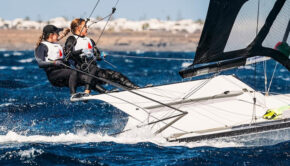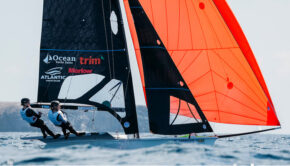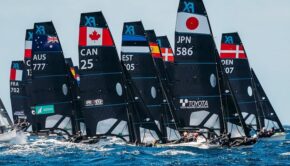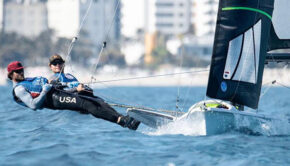Sailing as a Live TV Spectator Sport
Published on February 16th, 2016
by Justin Chisholm – Editor, Sail Racing Magazine
When people debate whether sailing can ever become a viable live TV sport, I have always resolutely clung resolutely to the fence. Sadly, in my heart of hearts, I have never really believed that it could.
Don’t get me wrong; I so much want the sport that captivated me when I first tried it at the age of nine and still holds me in its thrall now at 55 years of age, to finally have its time in the sun.
I dream of the day when mainstream global sporting public are given an insight into the magical hotchpotch of innate skill, nuanced tactics and strategy, meteorology, 3D-trigonometry, super athleticism, psychology, high-tech design and construction, hydrodynamics, aerodynamics and kinetics and all the other myriad of things that go to make up our glorious sport.
It’s not the fault of the TV companies. Like all other corporate organisations they are there to make money for their shareholders – not to give sailing its big break. Nor is it really, the fault of the various authorities that govern sailing. None of them are big enough or influential enough to grab the media’s attention in any meaningful way.
By its very nature, sailboat racing is not a sport that’s easy to cover live on TV. For a start, the action is weather dependent to a degree that gives the TV schedulers the absolute willies.
Yacht racing doesn’t take place in stadiums that can be festooned with cameras like football, rugby, cricket or baseball; nor does it happen on a race track or on city streets like motor racing or cycling. Even the sprawl of a golf tournament is easy pickings when you consider the challenge of covering an event taking place even a short distance out over water.
The few big properties in our sport with the financial wherewithal to bankroll the equipment, the the technology and the people to make it all work – I’m thinking here mainly of the 35th America’s Cup, the Volvo Ocean Race, and the Olympic Games – have made a pretty good fist of their coverage in recent years. Unfortunately, these events run on several year cycles and that makes it hard to hang on to any new fans during the downtime.
In recent years the former ISAF – now World Sailing – has tried to up the ante at their Olympic Classes Sailing World Cup events with the introduction of live coverage of the final day 10-boat medal races on YouTube. A great idea and a good chance to have regular top flight televised sailboat racing shows produced. Also, let’s remember that the double points medal races were introduced as a sop to TV audiences who wanted regattas to end with a climax.
Unfortunately – and without wishing to be unkind to those involved – that coverage has been pretty sketchy; often crippled by poor camera positions and inexperienced commentators. As a die-hard sailing supporter, I make the effort to watch it, but as an attempt to lure in new fans or generate interest from broadcast TV, it misses the mark by miles.
However, before we abandon all hope for live sailing ever making it on TV, there is a fairly sizeable glimmer of hope.
On February 9-14, three Olympic classes – the 49er, 49erFX and Nacra 17 – held a joint 2016 world championship in Clearwater, Florida, with the final days televised live on the 49er Sailing channel on YouTube. Nothing new in any of that, you might say, except that this time it was quite brilliantly done.
Visually we were treated to a solid blend of live TV and graphical fleet tracking information fed by SAP Analytics. The live TV footage came from a rock steady drone in the air, a couple of expertly handled stabilised camera out on the water, and some on-board fixed cameras spread around a few of the key boats.
Overlaid on this up was expert commentary from a team made up of British sailing journalist Andy Rice, New Zealand yachting presenter and journalist Peter Lester and Olympic 49er helmsman Marcus Baur.
The result for the audience watching on line was thoroughly exciting coverage of the racing via great aerial and boat to boat shots mixed slickly in with the graphics and the commentary.
It was a real pleasure to watch and learn from some of the best skiff and small catamaran sailors in the world. I would encourage anyone who is trying to improve their own starting, first beat strategy, or downwind performance, to check out the replay at the bottom of this page. I guarantee you will learn something!
I cannot say too much about how well I think the whole thing worked and I am hugely encouraged that we appear to have found an effective way of covering high-performance fleet racing. It’s mot perfect yet but it represents a very solid platform on which to build going forwards. I’m yet to get a feel for the budget for the coverage but the use of drones rather than helicopters must help to keep the overall figure down.
Here’s hoping that this team can be kept together and deployed at other top flight regattas this year, including, dare I say it, the biggest one of all taking place in August in Rio.
Source: Sail Racing Magazine
Live coverage replay from Saturday, February 13:
Live coverage replay from Sunday, February 14:









 We’ll keep your information safe.
We’ll keep your information safe.